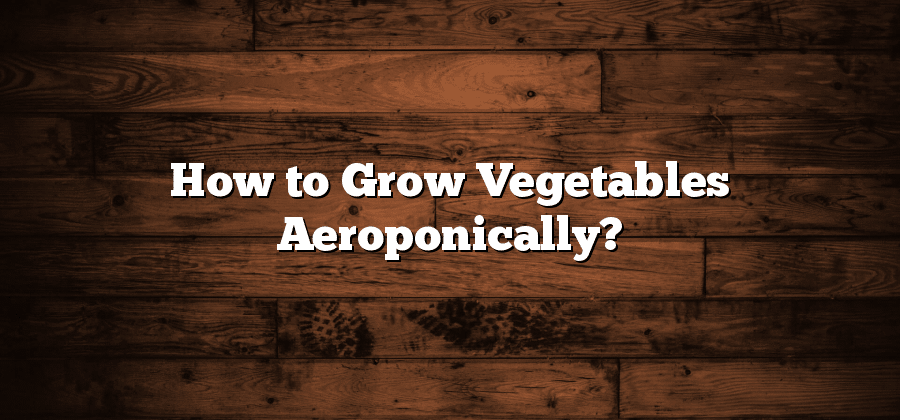Understanding Aeroponic Systems for Vegetable Growth
Aeroponic systems have gained immense popularity in recent years due to their efficiency in vegetable growth. Unlike traditional methods of cultivation, aeroponics allows plants to grow without soil, instead suspending the roots in an air or mist environment. This unique technique provides plants with optimal access to water, oxygen, and nutrients, resulting in faster and healthier growth.
The principle behind aeroponic systems lies in the delivery of nutrient-rich mist to the plant’s roots. This is achieved through the use of specialized nozzles, which produce a fine spray of water and nutrients. As the roots absorb these essential elements, the plant thrives and develops, leading to higher yields and improved overall quality. Furthermore, aeroponics offers greater control over factors such as temperature, humidity, and pH levels, allowing for precise adjustments to create the perfect conditions for vegetable growth.
Selecting the Ideal Vegetables for Aeroponic Cultivation
When it comes to selecting the ideal vegetables for aeroponic cultivation, there are several factors to consider. First and foremost, it is important to choose vegetables that are well-suited to hydroponic and aeroponic systems. These plants should have a high tolerance for the absence of soil and be able to thrive in a soilless environment. Some popular choices for aeroponic cultivation include lettuce, spinach, herbs such as basil and parsley, and leafy greens like kale and Swiss chard. These vegetables have proven to be highly successful in aeroponic systems, displaying robust growth and excellent yield.
In addition to considering the suitability of the vegetables for the aeroponic system, it is also important to take into account the specific needs and preferences of the plants. Each vegetable variety has its own unique requirements in terms of temperature, lighting, and nutrient levels. For example, leafy greens often prefer cooler temperatures and lower light levels, while herbs thrive in slightly warmer conditions and can benefit from higher light intensities. It is crucial to carefully research and understand the specific needs of each vegetable variety in order to provide the optimal growing environment and ensure successful cultivation in the aeroponic system.
Preparing the Aeroponic Setup for Successful Vegetable Growth
When preparing the aeroponic setup for successful vegetable growth, there are several key factors to consider. Firstly, it is essential to ensure that the system is clean and sanitized before planting. This helps to prevent the build-up of any harmful bacteria or diseases that could potentially hinder the growth of the vegetables. Additionally, it is important to check that all the necessary equipment and tools are in good working condition. This includes ensuring that the pumps, nozzles, and timers are functioning properly. By giving attention to these details, you can create an optimal environment for the vegetables to thrive.
Another crucial step in preparing the aeroponic setup is to choose a suitable growing medium. Unlike traditional soil-based cultivation, aeroponic systems rely on a different medium to support the plants. In aeroponics, the medium needs to be lightweight and provide excellent aeration to the roots. Many growers opt to use materials such as rockwool, vermiculite, or coconut coir, as these mediums offer ideal conditions for the vegetables to absorb nutrients efficiently. By selecting the right growing medium, you can ensure that the roots have proper support and access to the essential nutrients needed for healthy vegetable growth.
Providing the Right Nutrient Solution for Aeroponic Vegetables
A crucial aspect of successfully growing vegetables in an aeroponic system is providing the right nutrient solution. Unlike traditional soil-based cultivation, aeroponic systems rely on a nutrient-rich mist to nourish the plants. This nutrient solution is essentially a blend of essential minerals and nutrients that are dissolved in water and delivered directly to the plant roots.
When it comes to selecting the nutrient solution for aeroponic vegetables, it is important to consider the specific needs of the plants you are growing. Different vegetables require varying levels of nutrients, so it is essential to choose a solution that caters to these requirements. Typically, a balanced nutrient solution that contains all the essential elements like nitrogen, phosphorus, potassium, calcium, magnesium, and trace elements is recommended for optimum plant growth. Achieving the right balance of nutrients is key to ensuring healthy, productive vegetables in aeroponic systems.
Maintaining Proper Lighting and Temperature in Aeroponic Systems
To ensure successful vegetable growth in aeroponic systems, it is crucial to maintain proper lighting and temperature. Lighting plays a vital role in providing the necessary energy for photosynthesis, which is essential for plant growth. LED grow lights are commonly used in aeroponic systems due to their energy efficiency and ability to emit the right spectrum of light for optimal plant development. It is important to position the lights at the correct distance from the plants to avoid burning or stunting their growth.
In addition to lighting, temperature regulation is key in creating an ideal environment for aeroponic vegetable cultivation. The temperature should be maintained within a specific range to support plant growth and encourage root development. Generally, the ideal temperature range for most vegetables in an aeroponic system is between 65-75°F (18-24°C). Different vegetables may have slightly different temperature preferences, so it is essential to research the specific requirements of the crops being grown.
Maintaining proper lighting and temperature in aeroponic systems is crucial for providing the right conditions for vegetable growth. By ensuring the correct spectrum and intensity of light, as well as the appropriate temperature range, growers can maximize the potential of their aeroponic systems and optimize vegetable yields. However, it is important to regularly monitor and adjust these factors as needed since changes in seasons or plant growth stages may require alterations to lighting and temperature settings.






